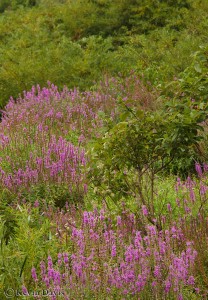Friday evening, as Hurricane Irene thrashed the coast of Florida, the weather in New England was clear and the warm glow of the setting sun raked across the land. I went a short distance down the road to photograph the river. But, to my surprise, the light on the weeds and grasses was largely back-lit and unflattering. So I planned to return and try again Saturday morning, as the weather forecast called for overcast clouds.

As expected, the morning provided soft diffuse light and I snapped a few images. To get a bit of elevation above the river, I used two familiar tools. One, a portable telescoping ladder. Two, a tripod fully extended and raised far over my head. The latter requires a bit more shutter speed to compensate for the unstable camera perch.
A bit later, after returning home, the sun was peeking through the clouds and I considered repeating my brief excursion in different light. But, in the end, I did not.
As you can see in the image here, the soft light features no distinct shadows. This is not automatically good or bad. A diffuse light avoids high contrast and specular reflections, but it can also reduce sense of shape and depth. A moderate light from the side (side light) will wrap around a subject and enhance the subject shape. But too much and the shadows may be too dark, loosing all details.
When dealing with natural light (not electronic flash), sometimes we can anticipate the light we want. But sometimes, the light really is not doing what we expect or want. When that happens, sometimes the right thing to do is simply try again after the light has changed.